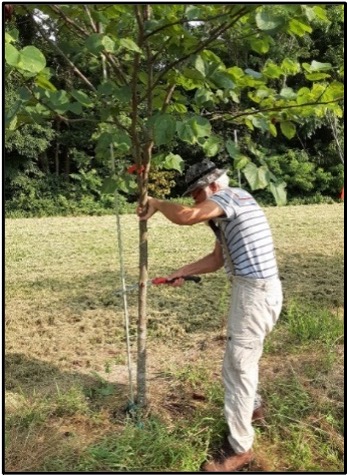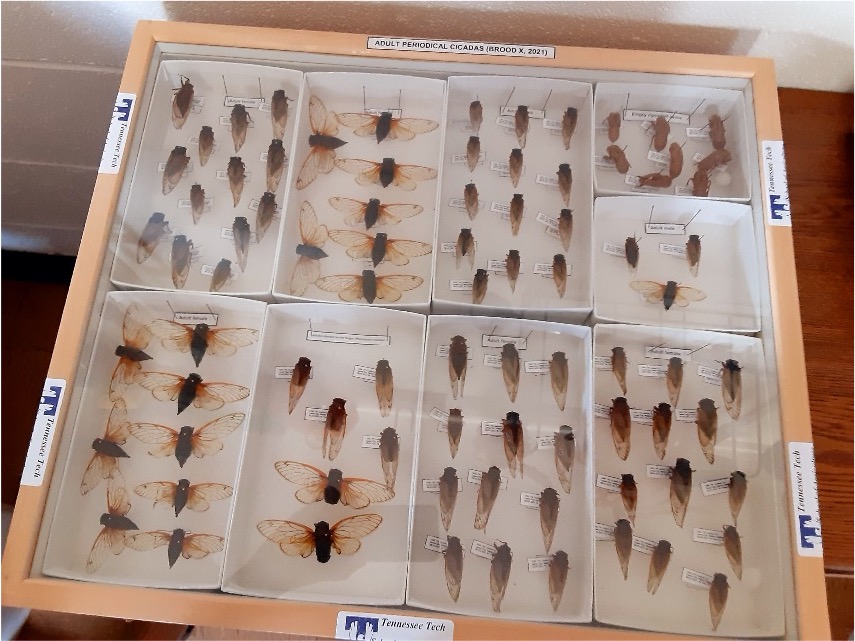Tech professor researching ways to mitigate periodical cicada damage

Douglas Airhart
The 17-year cicada and the 13-year cicada, which are periodical cicadas, are scheduled
to emerge in middle Tennessee during 2024 and 2025. A professor at Tennessee Tech
University is researching ways to prevent damage to nursery stock when these species
emerge in large numbers in chronologically and geographically isolated broods.
Douglas Airhart, professor and horticulturist, has received a research grant from
the Horticulture Research Institute to study how to prevent widespread devastation
of trees and financial loss to nurseries. He and his graduate assistant, Martine Bowombe-Toko,
are researching different methods to mitigate the damage that cicadas can do.
“In 2008 we had the 17-year cicadas emerge and in 2011 we had the 13-year cicadas
emerge. So, they're gonna be back,” Airhart said. “So, 2024 and 2025, back-to-back,
and that's why I have this project because the nurseries are going to be overwhelmed,
two years in a row.
“In some cases, the trees are damaged beyond recovery, what the insurance companies
designate as ‘damaged beyond recovery to sellable quality,’” Airhart said.
There are more than 3,000 known species of cicadas. Most are annual cicadas which
emerge yearly in midsummer, generally live for two to five years or longer and their
brood life cycles overlap, meaning that every summer, some cicadas emerge.
When the periodical cicadas emerge, they “just overwhelm an area,” according to Airhart.
This causes tree nurseries to lose millions of dollars due to loss of product.
The periodical cicadas are different. Shortly after the cicada nymph hatches from
its egg, it burrows into the ground where it spends the first 17 or 13 years of its
life. After that time, it emerges from the ground and only lives four to six more
weeks. In that time, it mates, fertilizes, or lays eggs, and dies, letting the life
cycle start all over again.
The use of netting, sound, motion, water soluble dyes, spraying chemical and natural
repellents such as diatomaceous earth or clay at the base of the trees, have all been
or are currently being researched as viable means of deterring the cicadas from harming
trees. Cicadas damage young saplings and trees up to five years old. 
Airhart tends to a tree at a commercial nursery site in Milton, Kentucky. Photo credit:
Bowombe-Toko and Airhart (2021).
Cicadas do have some redeeming qualities; they are a valuable food source for birds
and other predators. Cicadas can aerate lawns and improve water infiltration into
the ground, and they add nutrients to the soil as they decompose.
“Right now, I'm looking at my letters and reports. I have data from these nurseries
where there were some trees damaged, some undamaged, and some green and some all yellow,
and some were damaged beyond recovery,” Airhart said. “I'm trying to identify which
are these crops that were always damaged and then I got the idea to look at the crops
that were not damaged and figure out why.”
According to Airhart, cicadas do not seem to like conifer trees. These are trees that
bear their seeds in cones. Most conifers have needle-like or scale-like leaves and
keep their needles all year, thus they are called “evergreen.” Most of these trees
have a sticky sap which Airhart said could be why the cicadas avoid laying their eggs
in them. 
Airhart has been studying the periodical cicadas and identifying ways to stem their
damage.
“We often go to the evergreen trees and use nets to catch the cicadas because they
fly in, and they land on it, but they're not laying eggs in it,” he said.
While Airhart’s research will be beneficial to nurseries all over the world, those
close to home will be especially interested in his findings. Neighbors to the south
in McMinnville and Warren County will be watching his research. Known as the "Nursery
Capital of the World," McMinnville and Warren County are home to over 400 nurseries.
There the climate and soil conditions combine to offer a near-perfect growing environment.
Airhart plans to reapply for the Horticulture Research Institute again next year to
continue his research. This year was the second time he had received the grant. For
more information on horticulture visit https://www.tntech.edu/cahe/ag/areas-of-study/horticulture.php.

